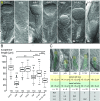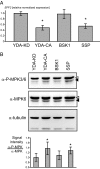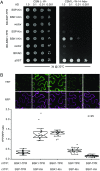Constitutive signaling activity of a receptor-associated protein links fertilization with embryonic patterning in Arabidopsis thaliana
- PMID: 30833400
- PMCID: PMC6431185
- DOI: 10.1073/pnas.1815866116
Constitutive signaling activity of a receptor-associated protein links fertilization with embryonic patterning in Arabidopsis thaliana
Abstract
In flowering plants, the asymmetrical division of the zygote is the first hallmark of apical-basal polarity of the embryo and is controlled by a MAP kinase pathway that includes the MAPKKK YODA (YDA). In Arabidopsis, YDA is activated by the membrane-associated pseudokinase SHORT SUSPENSOR (SSP) through an unusual parent-of-origin effect: SSP transcripts accumulate specifically in sperm cells but are translationally silent. Only after fertilization is SSP protein transiently produced in the zygote, presumably from paternally inherited transcripts. SSP is a recently diverged, Brassicaceae-specific member of the BRASSINOSTEROID SIGNALING KINASE (BSK) family. BSK proteins typically play broadly overlapping roles as receptor-associated signaling partners in various receptor kinase pathways involved in growth and innate immunity. This raises two questions: How did a protein with generic function involved in signal relay acquire the property of a signal-like patterning cue, and how is the early patterning process activated in plants outside the Brassicaceae family, where SSP orthologs are absent? Here, we show that Arabidopsis BSK1 and BSK2, two close paralogs of SSP that are conserved in flowering plants, are involved in several YDA-dependent signaling events, including embryogenesis. However, the contribution of SSP to YDA activation in the early embryo does not overlap with the contributions of BSK1 and BSK2. The loss of an intramolecular regulatory interaction enables SSP to constitutively activate the YDA signaling pathway, and thus initiates apical-basal patterning as soon as SSP protein is translated after fertilization and without the necessity of invoking canonical receptor activation.
Keywords: Arabidopsis thaliana; BRASSINOSTEROID SIGNALING KINASE; MAP kinase signaling; embryogenesis; evolution.
Conflict of interest statement
The authors declare no conflict of interest.
Figures






Similar articles
-
Independent parental contributions initiate zygote polarization in Arabidopsis thaliana.Curr Biol. 2021 Nov 8;31(21):4810-4816.e5. doi: 10.1016/j.cub.2021.08.033. Epub 2021 Sep 7. Curr Biol. 2021. PMID: 34496220
-
Paternal control of embryonic patterning in Arabidopsis thaliana.Science. 2009 Mar 13;323(5920):1485-8. doi: 10.1126/science.1167784. Science. 2009. PMID: 19286558
-
Transcriptional integration of paternal and maternal factors in the Arabidopsis zygote.Genes Dev. 2017 Mar 15;31(6):617-627. doi: 10.1101/gad.292409.116. Genes Dev. 2017. PMID: 28404632 Free PMC article.
-
YODA signalling in the early Arabidopsis embryo.Biochem Soc Trans. 2014 Apr;42(2):408-12. doi: 10.1042/BST20130230. Biochem Soc Trans. 2014. PMID: 24646252 Review.
-
The origin of the plant body axis.Curr Opin Plant Biol. 2012 Dec;15(6):578-84. doi: 10.1016/j.pbi.2012.08.001. Epub 2012 Aug 22. Curr Opin Plant Biol. 2012. PMID: 22921364 Review.
Cited by
-
Asymmetric cell division in plant development.J Integr Plant Biol. 2023 Feb;65(2):343-370. doi: 10.1111/jipb.13446. J Integr Plant Biol. 2023. PMID: 36610013 Free PMC article. Review.
-
A novel semi-dominant mutation in brassinosteroid signaling kinase1 increases stomatal density.Front Plant Sci. 2024 Apr 2;15:1377352. doi: 10.3389/fpls.2024.1377352. eCollection 2024. Front Plant Sci. 2024. PMID: 38628368 Free PMC article.
-
Salicylic acid attenuates brassinosteroid signaling via protein de-S-acylation.EMBO J. 2023 Jul 3;42(13):e112998. doi: 10.15252/embj.2022112998. Epub 2023 May 22. EMBO J. 2023. PMID: 37211868 Free PMC article.
-
Organ-level distribution tandem mass spectrometry analysis of three structural types of brassinosteroids in rapeseed.Front Plant Sci. 2024 Mar 7;15:1308781. doi: 10.3389/fpls.2024.1308781. eCollection 2024. Front Plant Sci. 2024. PMID: 38516662 Free PMC article.
-
Evidence of a novel silencing effect on transgenes in the Arabidopsis thaliana sperm cell.Plant Cell. 2023 Oct 30;35(11):3926-3936. doi: 10.1093/plcell/koad219. Plant Cell. 2023. PMID: 37602710 Free PMC article.
References
-
- Lau S, Slane D, Herud O, Kong J, Jürgens G. Early embryogenesis in flowering plants: Setting up the basic body pattern. Annu Rev Plant Biol. 2012;63:483–506. - PubMed
-
- Kawashima T, Goldberg RB. The suspensor: Not just suspending the embryo. Trends Plant Sci. 2010;15:23–30. - PubMed
-
- Bayer M, Slane D, Jürgens G. Early plant embryogenesis-dark ages or dark matter? Curr Opin Plant Biol. 2017;35:30–36. - PubMed
-
- Maheshwari P. An Introduction to the Embryology of the Angiosperms. McGraw–Hill; New York: 1950.
-
- Musielak TJ, Bayer M. YODA signalling in the early Arabidopsis embryo. Biochem Soc Trans. 2014;42:408–412. - PubMed
Publication types
MeSH terms
Substances
LinkOut - more resources
Full Text Sources
Other Literature Sources
Molecular Biology Databases

